I started uploading Let’s Play Metal Gear yesterday. You should go and watch that, if you haven’t. One of the first things I say in the first video of the series is that the game is not about sneaking or killing dudes, but about mapping. I mapped the hell out of Metal Gear, and if you don’t believe me, click these thumbnails and despair:
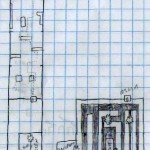
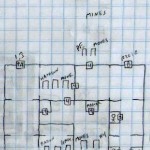
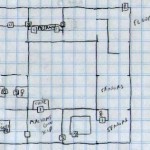
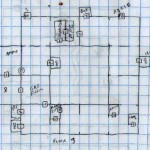
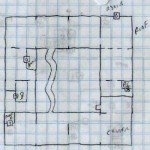
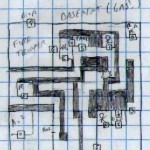
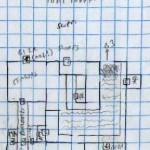
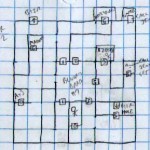
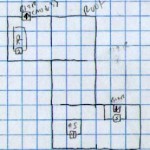
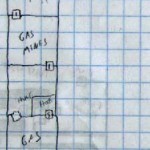
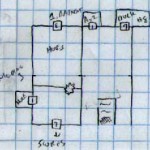
It took me a while to think of a good way to phrase my reasoning. At a purely technical level, MG2 is the superior game. It does more stuff, and does it better, than MG1, plus it throws in the compelling and/or long-winded narrative the series eventually became famous for. It switches up the way alerts are triggered and erased, which helps to create an atmosphere of sneaking around a forbidden place that the first game didn’t really nail. Soldiers had conical vision, so you can no longer hide two pixels outside their direct line of sight. You can crouch and crawl on the ground, which opens up a wealth of hiding spots and alternate paths. The nine-screen mini-map helps to plan routes, so areas of the game are handled more as actual areas and less as stand-alone rooms.
To extrapolate on that last point a bit, MG2 has a much better sense of place than MG1. I don’t think the actual game world is much bigger, but it is a lot denser, in that areas are used multiple times for multiple purposes, and you often have to go back to old areas in order to explore them in new ways. It helps the game to feel as though a plot is unfolding in a particular setting, rather than MG1‘s blatant and videogame-y series of levels.
All that said, though, MG1 is the better experience overall. A lot of that is just the primal joy I get from drawing and studying accurate game-world maps. This was neither required nor useful in MG2. More than that, though, I think MG2 tried to be a little too big for its britches. It’s one thing for a game to be ahead of its time, and another thing for a game to be ahead of its hardware generation. Simply put, MG1 felt like a fantastic 8-bit game, and MG2 felt like a well-intentioned 8-bit port of a 16-bit game. We used to see lots of these on the NES and Game Boy back in the early ’90s.
Let’s start with the plot. MG1‘s plot is nothing more than a justification to run Snake through a couple buildings full of soldiers and rolling barrel traps. You go in, you do the thing, you save the guy, you blow up the other guy, you get the credits. Top-down Mega Man, basically. In MG2, however, the plot is at the center of the game, with the gameplay draped over it. This means there are actual characters, and important dialogue, and plot twists to worry about. These things take time to introduce and develop… and that’s where it falls apart. No 8-bit hardware is up to the task.
We’ll take Gustava as an example. (This will work particularly well if you’ve played Metal Gear Solid, but nothing earlier.) At one point in the infiltration, Snake is told to hook up with a female soldier named Gustava who can help him contact the scientist he’s searching for. He does, and the two of them decide to work together. Just as it looks like they’re about in the clear, Gustava is cut down by the enemy and dies tragically in Snake’s arm, leaving the rest of her mission in his hands.
If this reminds you of Meryl Silverburgh, that’s because the entire subplot was re-packaged for the sequel. The difference is, the PS1 hardware had the muscle to sell the player on the whole Meryl plot. When Meryl and Snake spoke with each other they weren’t just two stacks of pixels in the middle of the screen; they were actual people who would move and react. When they spoke, their dialogue wasn’t just a box of letters you advanced with the A button; they were voice-overs, which brought a layer of emotion and inflection to the dialogue. And when Meryl finally got her fool self shot, it wasn’t just a screen flash followed by an abrupt change to a sideways stack of pixels. You heard a gunshot which sounded like a gunshot, a painful cry that sounded like a cry, and saw blood spatter that actually looked like blood spatter.
…and then your boss sent you on a stupid fetch quest back to the beginning of the game. Whatever. My point is this: the buildup of Snake and Meryl’s relationship, followed by the cinematics of her death, made me care about who she was and what her impact was on the story. Gustava, on the other hand… well, she’s in the game all of maybe twenty minutes. I had to Google her name a few paragraphs ago, because I had forgotten it.
One thing Metal Gear games are pretty consistently good it is showing part of its story as an extension of its gameplay. Even the original has its moments, such as when Snake recovers his equipment only to find a transmitter has been hidden in it. MG2 has a fair amount of this too, but again, it’s a little too meaty for its time. Lots and lots of, “Oh, I can see what they were going for here. But still, that was really annoying.”
A few examples. Most of the boss fights qualify, actually. The bosses in MG1 were mostly just standard top-down action game fluff — “shoot the bad guy more times than he shoots you” sort of affairs. The bosses in MG2 each had a twist or gimmick to them, and a lot of these twists don’t seem to work as advertised. One boss has perfect camo, and so is invisible, and you’re supposed to track him based on the sound his footsteps make against the different floor material across several screens. His bullets weren’t invisible, though, and there’s really no way he can stalk you in a top-down sprite-based game, so the real way to win the fight is to wait until he shoots you, shoot the spot the bullets are coming from, and then eat a ration when your life gets low.
Another: in one fight, the boss simply leaps on your back and starts choking you out. Since the game has no actions outside of Walk, Punch and Crouch, the only way to win is to send remote-control missiles at your own back. The battle is slapstick comedy at that point. Forget the boss music; someone should cue up Yakety Sax.
The most egregious of these is the temperature-sensative key. This is another feature MGS players will recognize: the player gets a key that takes a different shape depending on how hot or cold it is. So you bring it to a hot or cold room, depending on what you want to do with it. This was a little silly in MGS, but it was used mostly as a pacing technique. The scene is placed in between two thrilling boss fights, and various NPCs take the opportunity to advance the narrative as Snake is backtracking from place to place. Also, Snake is traversing relatively low-risk areas that he hasn’t spent a lot of time in yet, so it’s not really boring.
MG2‘s temperature key is just busywork. Instead of spacing out two boss fights, it spaces out a bad boss fight and an ill-conceived instant death trap (which could be another paragraph all its own). Instead of using the time to advance the narrative, characters on both sides of the radio stay silent the entire time, and nothing new or interesting happens. And instead of backtracking through a low-risk section the player is still somewhat new to, you’re backtracking through guard-infested territory you’ve already crossed many times. You dodge the same guards, in the same exact way, all because there’s only one fridge in the entire complex… for no reason other than someone thought the game needed to be twenty minutes longer. Bad!
The last major quibble I have with MG2 is its keycards. Snake tends to accumulate a stack of numbered cards as he goes through the game, and every single door he comes across can be opened by only a single card. The game tries to help you out by eventually consolidating some of the cards, so instead of systematically trying 1, then 2, then 3, he can try 1/2/3 all at once before moving up to 4, then 5, and so on. Still, this means four inventory transitions every time you find a new door. It annoyed me.
This did not annoy me in the original Metal Gear, which had far more doors and did nothing to consolidate anything. Why is that? Well, for one, I’d been carefully mapping each new room of MG1, so backtracking was as easy as glancing at my map to see which key I needed. Mapping is unnecessary in MG2, but that has the side effect of having no way of knowing what number each door was outside of rote memorization. And MG2 had lots more backtracking.
Aside from that, though, I think it was a matter of conditioning expectations. MG1 is a maze, and the game is about solving the maze, which means mapping and unlocking the maze. Actions taken in a maze often include putting the right pieces in the right slot, and numbered keycards are only one example of the sort of inventory gates MG1 uses. Broadly speaking, you just walk through the game equipping whatever the proper item is at the moment, until you win. Card #5 is no different from, say, a Compass or an Enemy Uniform in that sort of game.
MG2 is not a maze; it’s an adventure. The game is a sequence of events, which logically follow one another as the player moves through a world that is trying to sell itself on being realistic. Your inventory is no longer just a keyring; it’s a toybox. You often have to consider what items are — what they consist of, in some cases — and work out how to logically use them. This makes for really satisfying “aha!” moments, but rubbing keycards against doorknobs sticks out like a throbbing blister by comparison.
The problem need not exist, and I think that’s what bugged me. One solution would be to simply give me some visual indicator as to which card goes with which door. This need not be as blatant as slapping a 5 on every Card #5 door. Something subtle would do just as well. A color, a shape, the positioning of the hinges. Another “aha!” to discover. Or, more elegant still, go with MGS1‘s solution: each new keycard functions as all the cards beneath it, thereby making them redundant. Also does wonder for inventory clean-up.
None of this is to say Metal Gear 2 is a bad game, or that you should not play it. It’s a great game and you should play it, if for no reason than to understand its rightful place in gaming history. For us Ameritards who never had an MSX to play with, it also serves as a nice showcase of what 8-bit games looked and played like outside our little NES ghetto. I simply didn’t enjoy playing it as much as the original, is all. And it doesn’t lend itself as well to LPing.
If nothing else, the two games taken in aggregate paint a pretty hilarious picture of how practically every single scene in Metal Gear Solid was lifted wholesale from one of its prequels. I think the reason for that might be someone looking at the PS1 and saying, “Hey, all those great ideas from the pixel game that didn’t fly very well? Now they shall soar.“And since MGS2 is an admitted rehash ofMGS1, that means there weren’t any truly original gameplay ideas in the series until MGS3. Which is the series’s best game anyway, and the one you get if you want to download the MSX classics to your PlayStation. A nice little package, all in all. Highly recommended.
Interesting you should say MG2 doesn’t LP well, as it was the very first one.
What are some other games that you consider ahead of their hardware instead of their time?
More than that, though, I think MG2 tried to be a little too big for its britches. It’s one thing for a game to be ahead of its time, and another thing for a game to be ahead of its hardware generation. Simply put, MG1 felt like a fantastic 8-bit game, and MG2 felt like a well-intentioned 8-bit port of a 16-bit game.
It’s interesting that you mention that, since Metal Gear 1 itself is the result of serious hardware limitations. Sirlin has a good overview of a GDC presentation Kojima made about it a few years back, but to put it simply he was directed to make an action game for a platform that literally couldn’t display enough sprites in a row; especially since having multiple colours on a sprite was actually layering multiple sprites on top of each other!
The rest of the presentation is also super interesting, since it’s about how he dealt with hardware limitations in his quest to make the game that will let him stop making more Metal Gear games.
I imagine you feel you same way about Metal Gear Solid (aka Ghost Babel) for the GBC that you do about MG2, eh?